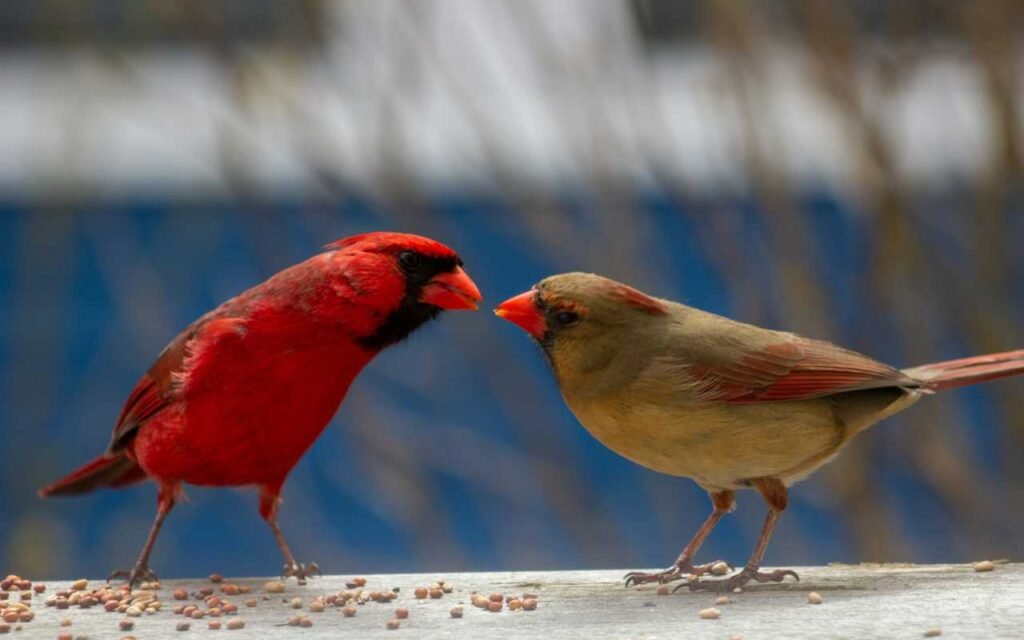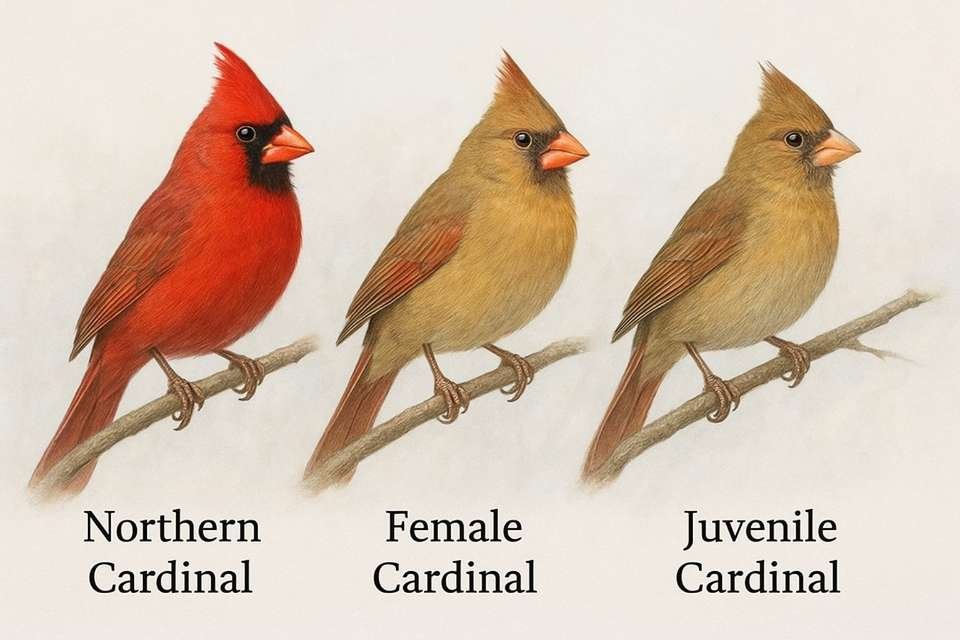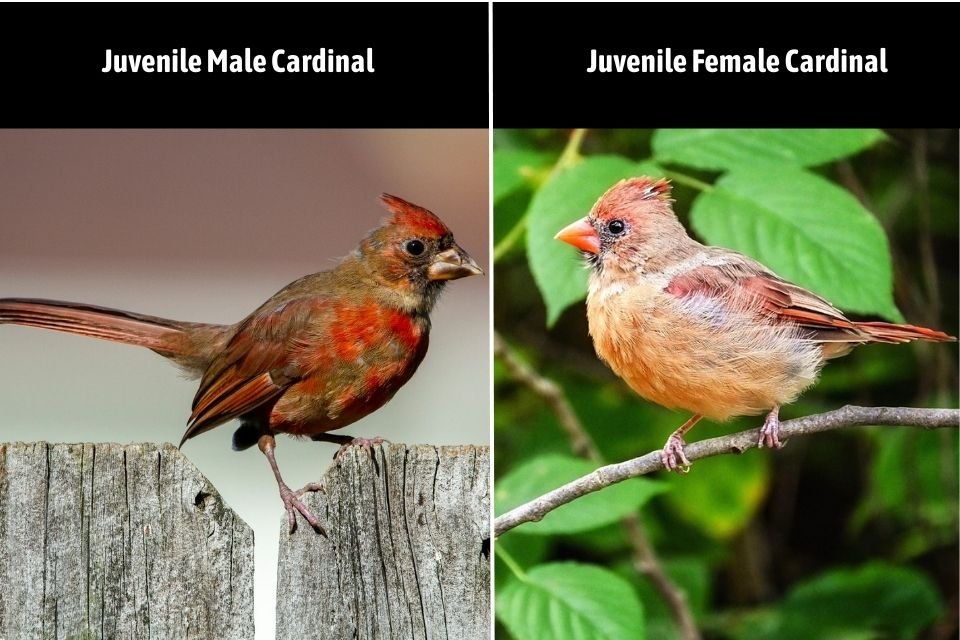Picture this: you’re sitting by your window with your morning coffee, and a gorgeous red flash catches your eye at the feeder. “Cardinal!” you think excitedly. But then you notice another bird nearby that’s more brownish-red, and you start wondering if you’re seeing two different species or just totally confused 🤔. Trust me, I’ve been there more times than I care to admit.
The truth is, male vs female cardinal identification trips up even experienced birders sometimes. I remember spending an entire afternoon convinced I had some rare cardinal variant in my yard, only to realize I was watching a perfectly normal female. Embarrassing? Maybe. Educational? Absolutely. Let me save you from making the same rookie mistakes I did.
The Obvious Differences You Can Spot Instantly
When it comes to cardinal gender differences, nature made things pretty straightforward once you know what to look for. The good news is that cardinals are one of the easier birds to sex, especially compared to those tricky little brown jobs that all look identical.
Male Cardinals: The Show-Offs
Male cardinals are basically the peacocks of the backyard bird world. They sport that brilliant, fire-engine red plumage that makes them impossible to miss. According to the American Bird Conservancy, male cardinals are bright red all over, with a reddish bill and black face immediately around the bill. I call them the “look at me” birds, and honestly, who can blame them? When you’re that stunning, why not flaunt it?
The male cardinal identification starts with that unmistakable red. We’re talking about a rich, vibrant red that covers almost their entire body. Their crest, back, wings, tail, and underparts are all various shades of red. The only contrast comes from their jet-black face mask that extends around their eyes and down to their throat, creating a striking bandit-like appearance.
Their beaks are thick, conical, and bright orange-red, perfect for cracking seeds. During breeding season, these beaks become even more vibrant, like nature’s way of adding extra bling.
Genetic research (including the CYP2J19 gene) confirms that the red plumage in male Northern Cardinals is tightly regulated at the molecular level, which is why diet and condition can affect how red a male looks. (De Novo Cardinal Genome Study)
Ever noticed how some male cardinals look redder than others? That’s often related to diet and age – older, well-fed males tend to show the most intense coloration.
Female Cardinals: The Understated Beauties
Now, female cardinal traits are where things get interesting. These ladies are the masters of subtle elegance. According to Celebrate Urban Birds, females are pale brown overall with warm reddish tinges in the wings, tail, and crest.
The red isn’t absent – it’s just more strategically placed. You’ll see lovely red-orange highlights on the tips of their wings, tail feathers, and that adorable pointed crest. Their beaks are the same thick, seed-cracking shape as the males, but they’re usually more orange than red. The face mask?
Much more subtle or sometimes barely visible. Instead of that dramatic black bandit look, females have more muted facial features that blend beautifully with their overall coloring.
Juvenile Cardinals: The Awkward Teenagers
Juvenile cardinals look like the in-between stage of birdhood. They’re mostly dull brown with a slightly scruffy appearance, lacking the polished colors of adults. Their beaks start out dark before turning bright orange-red as they mature. According to the Cornell Lab of Ornithology, juvenile male cardinals resemble females until their adult plumage develops. Unlike adults, their black face mask is either missing or very faint, which makes them look like a “work in progress” version of their parents.
Adding to that, Birdfact notes that young cardinals of both sexes look remarkably similar to adult females, but there are subtle differences that help you tell them apart. Juvenile males start showing hints of red earlier than you might expect, though it’s patchy and uneven—think of a female cardinal sprinkled with random red feathers as he figures out his adult colors.
Their beaks are also darker, more grayish-orange rather than the bright orange-red of adults. Juvenile females look very similar to adult females but tend to be slightly duller overall. Their beaks are darker too, and they often have a fluffier, less sleek appearance.
Unlike adults, their black face mask is faint or missing entirely, which makes them look like “work in progress” versions of their parents—awkward, patchy, and a little unpredictable.
Beyond the Basics: Subtle Clues That Matter
Once you’ve mastered the obvious cardinal plumage differences, let’s talk about the details that separate casual observers from true cardinal experts. These subtle differences can help you identify birds even when lighting conditions aren’t perfect or when you’re watching from a distance.
Size and Body Language
Here’s something most people don’t realize: northern cardinal male vs female differences extend beyond just color. Males are typically slightly larger and more robust-looking than females. It’s not a huge difference, but once you start paying attention, you’ll notice it.
Males also tend to be more territorial and aggressive, especially during breeding season. I’ve watched male cardinals chase off other males with an intensity that’s both impressive and slightly comical. They puff up their chest feathers, raise their crest, and basically turn into tiny feathered bodybuilders.
Females, on the other hand, tend to be more cautious and observant. They spend more time scanning for potential threats before committing to a feeding spot. Smart ladies – they’ve got eggs and babies to think about.
Behavioral Differences That Give Them Away
Want to know a secret? Sometimes behavior tells you more than appearance. Male cardinals are the singers of the family. If you hear that classic “birdy-birdy-birdy” or “cheer-cheer-cheer” call, you’re almost certainly listening to a male defending his territory or trying to impress a female.
Females can sing too, but they do it much less frequently and usually more quietly. When they do vocalize, it’s often a softer, more conversational sound. During nesting season, I’ve noticed females make a lot of subtle contact calls to communicate with their mates.
Seasonal Changes That Might Fool You
Here’s where things get tricky, and honestly, where I got fooled for years. Cardinal identification isn’t always consistent throughout the year, and these seasonal changes can really mess with your confidence.
Winter vs. Summer Males
Male cardinals aren’t quite as brilliant in winter as they are during breeding season. Their red can appear slightly duller, almost like someone turned down the saturation on a photo. According to All About Birds, by midwinter, cardinals are approaching maximum redness after molting into and polishing up a new set of feathers. The edges of their feathers might look a bit brownish or grayish, especially on newly molted birds.
Don’t panic if your male cardinal looks a bit dull in December – he’s not sick, just rocking his winter wardrobe. Studies show that environmental factors, especially urban ones like pollution, light levels, and habitat can actually affect how bright his feathers appear (Jones et al., Variation in Plumage Coloration of Northern Cardinals). Come spring, those hormones kick in, and he’ll be back to his show-stopping best.
Juvenile Cardinals: The Ultimate Tricksters
Oh boy, juvenile cardinals. These little troublemakers had me questioning everything I thought I knew about how to identify cardinals. Young cardinals of both sexes look remarkably similar to adult females, but with some key differences that can help you tell them apart.
Adding to that, Birdfact notes that young cardinals of both sexes look remarkably similar to adult females, but there are subtle differences that help you tell them apart. Juvenile males start showing hints of red earlier than you might expect, though it’s patchy and uneven—think of a female cardinal sprinkled with random red feathers as he figures out his adult colors.
Their beaks are also darker, more grayish-orange rather than the bright orange-red of adults. Juvenile females look very similar to adult females but tend to be slightly duller overall. Their beaks are darker too, and they often have a fluffier, less sleek appearance.
Unlike adults, their black face mask is faint or missing entirely, which makes them look like “work in progress” versions of their parents—awkward, patchy, and a little unpredictable.
Common Mistakes Even Experienced Birders Make
Let me share some embarrassing moments that taught me valuable lessons about cardinal identification. Maybe my mistakes can save you some confusion :/.
The “Rare Cardinal” Mix-Up
I once got super excited thinking I’d discovered some rare cardinal variant, only to realize I was looking at a female in perfect lighting conditions. The morning sun was hitting her reddish highlights just right, making them appear much more vibrant than usual. Lesson learned: lighting can dramatically change how cardinal plumage differences appear.
The Molt Confusion
During molting season, even experienced birders can get thrown off. I’ve seen males mid-molt that looked patchy and weird, with missing head feathers that made their black mask look completely different. If you see a cardinal that looks “off,” consider whether it might be going through a molt.
Distance and Weather Effects
Rainy, overcast days can make male cardinals look much duller, while bright, sunny days can make females appear more vibrant. I’ve learned to consider weather and lighting conditions when making identifications, especially when I’m birding from a distance.
Quick Reference: When You Need to Know NOW
Sometimes you need fast male cardinal identification because that bird isn’t going to stick around forever. Here’s my personal quick-check method that works about 99% of the time.
Bright red all over with black face? Male, no question. Brown with red highlights? Female or juvenile. Patchy red and brown? Probably a juvenile male. Singing loudly? Almost certainly a male.
The beak color can also be a quick tell – bright orange-red usually means adult, while duller orange or gray suggests juvenile.
Why These Differences Matter
Understanding northern cardinal male vs female differences isn’t just about showing off your birding knowledge (though that’s fun too). According to this study, these differences tell a fascinating story about survival, evolution, and the roles each sex plays in cardinal society.
Males are bright and conspicuous because they need to attract mates and defend territories. That flashy red plumage is basically a neon sign saying, “I’m healthy, strong, and would make excellent father material.” The trade-off? They’re more visible to predators.
Females evolved their more subtle coloring for completely practical reasons. When you’re sitting on a nest for weeks, blending in with your surroundings can literally be a matter of life and death. Their coloring provides perfect camouflage among dead leaves and brown twigs.
Making the Most of Your Cardinal Watching
Now that you know how to identify cardinals with confidence, you can really start appreciating the subtle dramas playing out in your backyard. Watch for pair bonding behaviors, where males feed females during courtship. Look for territorial disputes between males. Notice how females carefully scout feeding areas before committing.
I keep a simple notebook by my window where I jot down interesting cardinal behaviors I observe. Over time, you start noticing patterns and personalities. That slightly more aggressive male might be the same one you see every day. That cautious female might be the one who successfully raised three broods last summer.
Final Thoughts: Embracing the Learning Curve
Learning cardinal gender differences is like learning any new skill – it takes practice, and you’ll make mistakes. I still occasionally second-guess myself when lighting conditions are weird or when I’m dealing with juveniles in transition.
The key is to enjoy the process. Every time you correctly identify a female cardinal or spot a juvenile male starting to show his colors, you’re connecting more deeply with the natural world around you. And honestly, cardinals are pretty forgiving subjects for practicing your identification skills.
Next time you’re watching your feeders and spot those familiar red flashes, take a moment to really observe. Notice the subtle differences, the behaviors, the way light plays on their feathers. IMO, the more you pay attention, the more amazing these common backyard birds become. Who knew something so familiar could still surprise you?





